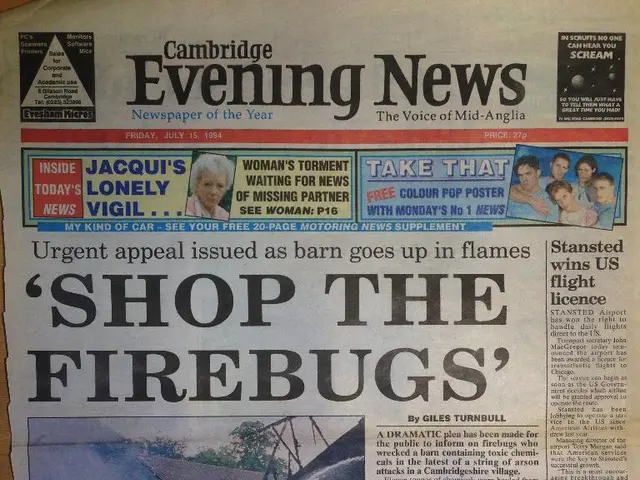Behind the Shield: Potential Adverse Effects of Keratin Hair Treatments
Get the scoop on keratin treatments and their potential side effects, focusing on the threat posed by formaldehyde exposure. Explore how these popular hair smoothing treatments could impact your health and learn about safer alternatives for buttery soft, frizz-free locks.
Curious about the hairdo hype? Keratin treatments are chemical applications that make your tresses straight, glossy, and frizz-free for months on end. But hold on tight, there are some hidden risks to consider.
Let's dive deep into possible side effects of keratin treatments, paying special attention to formaldehyde – the culprit at the center of the storm.
Keratin treatment side effects – the lowdown
Keratin treatment side effects may vary, depending on the cocktail of chemicals used by your stylist. Generally, the rogue ingredient formaldehyde steals the spotlight when it comes to risks. It can cause:
- Headaches
- Watery, itchy, burning eyes
- Sensations of burning in your eyes, nose, and throat
- Skin irritation like burning, itching, rashes, or hives
- Respiratory symptoms such as coughing, wheezing, or chest tightness
Formaldehyde is a known carcinogen, so longer-term exposure may increase your risk of getting cancer[3].
What's really in a keratin treatment?
Keratin treatments are made from keratin, a protective protein found in your hair, nails, and skin. The keratin used in these treatments is usually animal-based, making them not vegan-friendly. They also contain chemicals that force your hair to behave, with formaldehyde being the main bad boy[6].
Are keratin treatments safe?
When used on its own, keratin is typically considered safe as a cosmetic hair treatment. But the added chemicals can raise eyebrows, and formaldehyde is the prime suspect[6].
Formaldehyde and cancer risk
If your stylist employs a formaldehyde-laden formula, some of it can be inhaled or absorbed through your skin during the treatment. This compound is classified as a known carcinogen[3].
Respiratory troubles
Not only is formaldehyde a carcinogen, but frequent exposure in a salon setting may also lead to temporary or chronic respiratory symptoms, including wheezing, coughing, shortness of breath, and changes in lung function[2].
Possible keratin treatment side effects
Keratin treatment reactions can range from barely noticeable to severe. Here are some potential side effects, as outlined by the Occupational Safety and Health Administration (OSHA)[5]:
- Respiratory issues: Concentrations above 50 parts per million can cause fluid in the lungs or bronchial irritation. Even lower concentrations can cause chest tightness, wheezing, coughing, and a burning sensation in your lungs and nose.
- Eye irritation: Direct eye contact can cause damage to the corneas, potentially leading to scarring or clouding. It can also cause burning, redness, itching, and tearing.
- Skin reactions: A mild burning sensation is common during a keratin treatment, but some may experience allergic reactions, hives, or inflammation.
- Gut issues: Formaldehyde is not meant for consumption and can cause nausea, vomiting, and stomach pain if ingested. In severe cases, it can also cause organ damage and death.
- Pregnancy concerns: Formaldehyde exposure may lead to fertility problems and raise the risk of miscarriage[2].
Formaldehyde-free keratin treatments
Beware of products that claim to be formaldehyde-free. brands can be sneaky, hiding formaldehyde under different names such as:
- formalin
- methanal
- methanediol
- methyl aldehyde
- methylene oxide
- formic aldehyde
- methylene glycol
Avoid preservatives that can release formaldehyde, such as:
- quaternium-15
- diazolidinyl urea
- benzylhemiformal
- imidazolidinyl urea
- 5-bromo-5-nitro-1,3-dioxane
- 2-bromo-2-nitropropane-1,3-diol
- sodium hydroxymethylglycinate
- 1,3-dimethylol-5,5-dimethylhydantoin (or DMDM hydantoin)
Alternatives to keratin treatment
Think twice before jumping on the keratin treatment bandwagon. You've got some safer alternatives to consider:
- Japanese straightening – a chemical process that can leave your hair straighter and shinier for up to 6 months, without the formaldehyde[7]
- Tourmaline hair-smoothing treatment – an at-home hair-smoothing treatment that's cost-efficient and formaldehyde-free, given you find a 100 percent natural formula[7]
- Hot oil treatment – a plant-based treatment that seals your hair cuticle, reducing frizz and giving your locks a glossy finish[8]
tl;dr
Keratin treatments offer sleek, manageable hair for months, but at a cost. Forms of formaldehyde used in these treatments have been linked to several health risks and side effects, including cancer, respiratory problems, skin irritation, eye problems, stomach ailments, and adverse pregnancy outcomes.
If you're not ready to kiss those curls goodbye or want to opt for a safer hair care solution, consider alternative treatments like Japanese straightening, tourmaline hair-smoothing treatment, or hot oil treatment.
- Using keratin treatments could expose individuals to formaldehyde, a known carcinogen, which may cause various health risks such as headaches, eye irritation, skin irritation, respiratory symptoms, stomach issues, and potential pregnancy concerns.
- sensitivity to formaldehyde may result in severe reactions, including nausea, vomiting, and organ damage in extreme cases.
- To minimize potential risks, consider exploring alternative hair care solutions like Japanese straightening, tourmaline hair-smoothing treatment, or hot oil treatment, which can provide frizz-free locks without the added formaldehyde.




